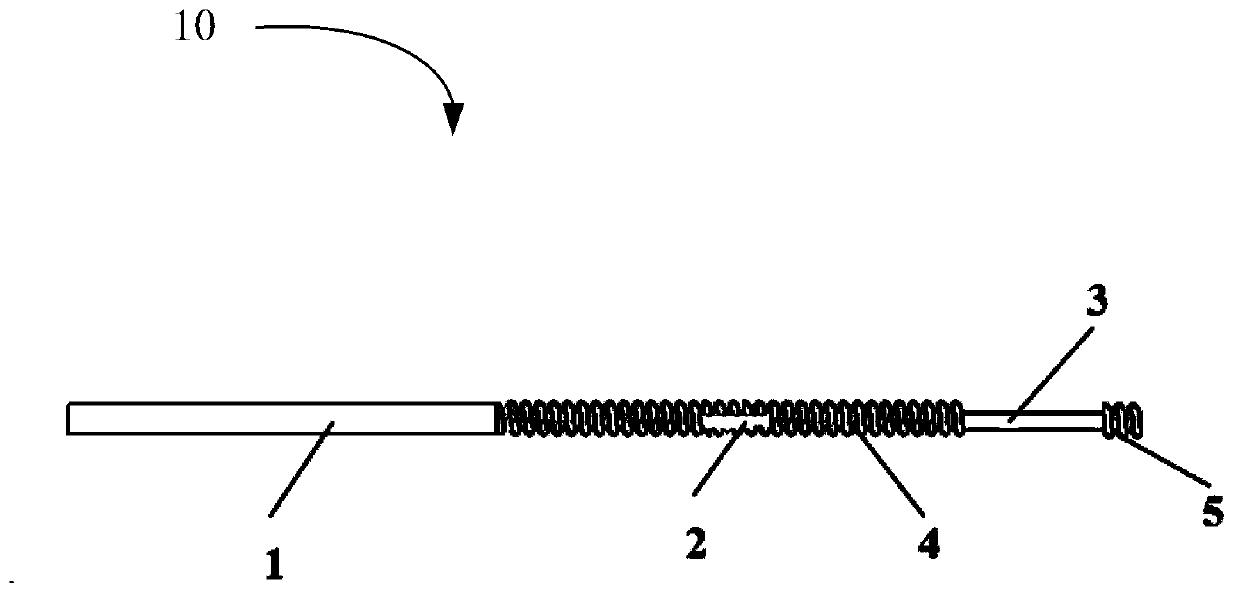Ceramic halogen lamp electrode and ceramic halogen lamp
A ceramic metal halide lamp and electrode technology, applied in the field of ceramic metal halide lamp electrodes and ceramic metal halide lamps, can solve problems such as radioactive pollution, and achieve the effects of avoiding radioactive pollution, avoiding impact, and improving lifespan
- Summary
- Abstract
- Description
- Claims
- Application Information
AI Technical Summary
Problems solved by technology
Method used
Image
Examples
preparation example Construction
[0032] The preparation method of the above-mentioned luminescent pill comprises the following steps:
[0033] Step S110, sodium iodide (NaI), thallium iodide (TII) and indium iodide (InI 3 ) and the resulting mixture was vacuum treated at 130 °C for 50 min.
[0034] Sodium iodide (NaI), thallium iodide (TII) and indium iodide (InI 3 ) The mass ratio is 0.005~0.015:6.0×10 -4 ~7.0×10 -4 :4.0×10 -5 ~4.7×10 -5 .
[0035] Preferably, the mixture is placed in a quartz container with a nozzle for vacuum treatment.
[0036] Step S120, heating the mixture until melting, and stirring for 30 minutes.
[0037] Step S130, under the atmosphere of protective gas, make the molten mixture into a spherical shape and cool down to obtain a luminous pill.
[0038] Preferably, the protective gas is selected from at least one of argon and nitrogen.
[0039] Preferably, the molten mixture is sprayed through a nozzle to form the molten mixture into a spherical shape.
[0040] Preferably, the...
Embodiment 1
[0050] The ceramic metal halide lamp electrode includes a lead wire 1 , a connecting rod 2 , an electrode rod 3 , a molybdenum wire helix 4 and a tungsten wire helix 5 . One end of the lead wire 1 is connected to one end of the connecting rod 2 . The material of the lead wire 1 is niobium. The lead wire 1 is rod-shaped and coaxial with the connecting rod 2 . In this embodiment, the lead wire 1 is connected to one end of the connecting rod 2 by welding. The material of the connecting rod 2 is niobium. One end of the electrode rod 3 is connected to the end of the connecting rod 2 away from the lead wire 1 . In this embodiment, one end of the electrode rod 3 is connected to one end of the connecting rod 2 by welding. The connecting rod 2 is coaxial with the electrode rod 3 . The material of the electrode rod 3 includes tungsten, zirconia and scandia. The total mass percentage of zirconia and scandium oxide in the electrode rod 3 is 0.2%, and the rest is tungsten. The mass ra...
Embodiment 2
[0056] The structure of the light-emitting electrode of the ceramic metal halide lamp in Example 2 is roughly the same as the structure of the light-emitting electrode of the ceramic metal halide lamp in Example 1. The difference is that in Example 2, the material of the electrode rod 3 includes tungsten, zirconia and Scandium oxide, the total mass percentage of zirconia and scandium oxide in the electrode rod 3 is 2%, the rest is tungsten, and the mass ratio of zirconia to scandium oxide is 1.4:1.
[0057] Apply ceramic metal halide lamp electrodes and luminescent pills to ceramic metal halide lamps. In this metal halide lamp, the arc tube volume is 0.28cm 3 , the distance between electrodes is 7mm, mercury is 0.3mg, xenon is 5 atmospheres, and the mass ratio of sodium iodide, thallium iodide and indium iodide in the selected luminous pill is 0.01:6.6×10 -4 :4.4×10 -5 . The weight of the luminescent pill is 0.3mg, and the particle size is 0.3mm. The luminous efficiency of...
PUM
| Property | Measurement | Unit |
|---|---|---|
| diameter | aaaaa | aaaaa |
| weight | aaaaa | aaaaa |
| weight | aaaaa | aaaaa |
Abstract
Description
Claims
Application Information
 Login to View More
Login to View More - R&D
- Intellectual Property
- Life Sciences
- Materials
- Tech Scout
- Unparalleled Data Quality
- Higher Quality Content
- 60% Fewer Hallucinations
Browse by: Latest US Patents, China's latest patents, Technical Efficacy Thesaurus, Application Domain, Technology Topic, Popular Technical Reports.
© 2025 PatSnap. All rights reserved.Legal|Privacy policy|Modern Slavery Act Transparency Statement|Sitemap|About US| Contact US: help@patsnap.com


